Going for Gold in Asia Pacific!

Capture the Fracture highlights champions in secondary fracture prevention
Nine gold-standard Fracture Liaison Services (FLS) in the Asia Pacific region have participated in a campaign launched by the International Osteoporosis Foundation’s Capture the Fracture® (CTF) programme to share insights and to inspire FLS services around the world to ‘go for gold’.
While the world was watching the highest level of athletic achievement at the 2024 Summer Olympics in Paris, other champions around the world were performing at Gold-Medal levels of fracture care and prevention. Through their expertise and extraordinary commitment to secondary fracture prevention, these gold-level Fracture Liaison Services (FLS) have achieved the highest standards of post-fracture care for their patients, as assessed by the Capture the Fracture® (CTF) Best Practice Framework.
Eighteen of the 120 Gold-level FLS within the CTF network, which comprises more than 1000 FLS worldwide, responded to a call for participation in a campaign launched for World Osteoporosis Day – nine from Asia Pacific, six from Europe, and two from Latin America. The campaign aims to celebrate hospitals achieving the highest level of care according to international standards, while raising awareness of the urgent need for accessible gold-standard care for all patients who suffer a fragility fracture. Everyone wins with gold-standard fracture care and prevention!
IOF thanks the following contributing FLS in the Asia Pacific for their insights about key strategies needed to reach gold standard level of care:
Hayato Orthopedics Hospital, Kagoshima, Japan
The Hayato Orthopedics Hospital became a gold-level FLS in 2022. It manages all types of fractures, and sees approximately 450 patients per year. The FLS is comprised of a multidisciplinary team comprising orthopaedist, FLS coordinators, radiographers, and dietitians.
“We participated in the FLS as part of our efforts to safeguard the health of everyone in our community. We will continue striving to reduce the number of patients affected by secondary fractures.”

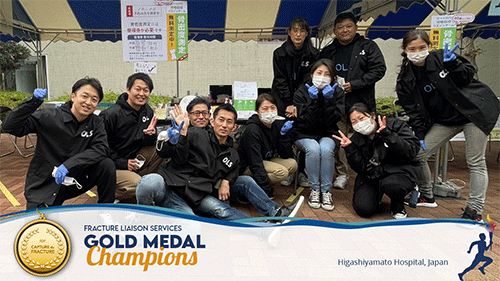
Higashiyamato Hospital, Tokyo, Japan
The Higashiyamato Hospital FLS has been part of the Capture the Fracture® programme since 2021, and in the last few years it has made great strides to identify outpatient fractures such as femur and humerus. Achieving gold-level recognition in 2023, the FLS manages all fracture types and sees approximately 3360 patients per year.
“First, our team established a task force for the identification and improvement of previous application issues; second, we set a goal to achieve a gold score - as an annual goal. Finally, we shared information and collaborated with other members. When it comes to post-fracture care, we believe that patients must realize their symptoms and take measures after being aware of their condition.”
Tokushima Kensei Hospital, Tokushima, Japan
The Tokushima Kensei Hospital FLS became a CTF gold-level service in 2023. The FLS sees approximately 160 patients per year, managing all fracture types. Dr Kazuaki Mineta, an orthopaedist, is the champion of the "Fracture Zero team", working with a multidisciplinary team including three FLS coordinators. The hospital has established a clinical pathway to perform bone mineral density testing and treatment for all patients with hip and vertebral fractures. For other fractures, the orthopedic surgeons make the decision to measure bone mineral density, diagnose osteoporosis, and begin drug treatment.

« Our hospital's clinical pathway for preventing secondary fractures from bone fragility fractures has been created to allow not only drug treatment but also collaboration among multiple professions. As our team name suggests, our goal is of course zero fractures, but we are also working on preventing secondary fractures with a "stop at one" mentality, because we want to see a future where as many patients as possible can walk on their own legs, healthy even at age 100. »

The JCHO Tamatsukuri Hospital FLS achieved gold-standard recognition in 2020. It sees approximately 452 patients each year, and manages all fracture types. The osteoporosis and falls prevention team (called "TAMATSUKU RE:BONE") organizes weekly meetings to discuss specific patient cases and to brainstorm new ways of improving the quality of their service.
“With collaboration between various professions led by a osteoporosis manager, we work hard to prevent primary fractures to prevent the first fracture and secondary fractures to break the fracture chain. We hope that through this campaign and World Osteoporosis Day, people in the community will take a greater interest in their own bone health. We will continue to do our utmost to prevent fragility fractures due to osteoporosis in the local community and support their vibrant and healthy futures, aiming to win the "gold medal" in fracture care and prevention.”
The Waitemata DHB FLS has been running since 2012, and is one of the first FLS ever established in New Zealand. The service has progressively grown and matured over the years, manages all fracture types, and seeing approximately 1120 patients per year.
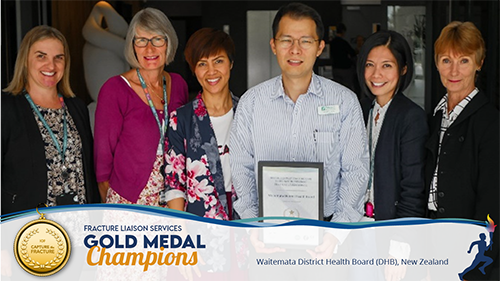
“Waitemata FLS was able to achieve the ‘gold standard’ in 2021 and further improve on the breadth and quality of the care we provide in recent years. Having ‘beacons’ for the service to follow in the form of IOF’s ‘Best Practice Framework’ and Osteoporosis New Zealand’s ‘Clinical Standards for Fracture Liaison Services in New Zealand’ were crucial. We always focused on working on areas of our service we believed would lead to actual future fracture reduction (e.g. increasing treatment rate, improving access to DXA scanning, improving falls prevention) while respecting individual patients’ choices and autonomy. We feel that this patient-centred approach in implementing our fracture reduction strategies will lead to better intervention adherence and, ultimately, less fractures over time.”
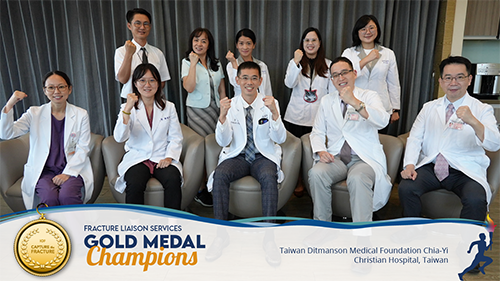
Ditmanson Medical Foundation Chia-Yi Christian Hospital, Chia-Yi City, Taiwan
The Ditmanson Medical Foundation Chia-Yi Christian Hospital FLS, which was recognized as a gold-level service in 2022, serves a community of over 500,000 people, including Chia-Yi county, the most aged city in Taiwan. More than 1500 patients come to the hospital for treatment of fragility fractures, such as hip, vertebra and wrist fractures.
“Our success in attaining gold standard service is largely due to our meticulous attention to every detail of patient care. We focus on educating patients about the importance of osteoporosis treatment, ensuring they understand the long-term benefits, and addressing their concerns regarding medications, including potential side effects, drug efficacy, and delivery methods. By engaging in open discussions, we tailor treatment plans to meet individual patient needs, which helps us reduce medication discontinuation rates.”
“In terms of post-fracture care and secondary fracture prevention, we prioritize identifying all types of fragility fractures, even those not covered by Taiwan’s health insurance, such as distal radius or proximal humerus fractures. We actively recommend osteoporosis screening and treatment for at-risk patients, even if it requires out-of-pocket expenses for supplements like calcium and vitamin D. By doing so, we ensure that patients receive comprehensive care, and this approach has been well received by our community. Our case managers also play a crucial role in this continuous care, ensuring that no patient falls through the cracks.”
Thailand Police General Hospital, Bangkok, Thailand
The Thailand Police General Hospital (PGH) achieved gold-standard recognition in in 2016 and it was the first FLS in Thailand to achieve this milestone. The PGH’s FLS handles all inpatients’ fragility fractures, serving about 120 patients per year.
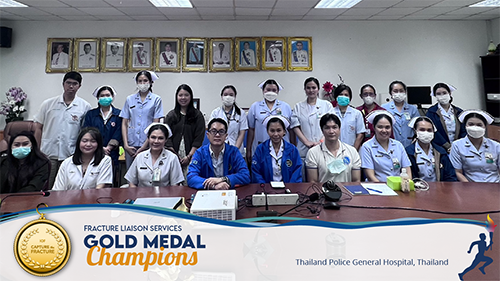
"The Police General Hospital's Fracture Liaison Service FLS prioritizes secondary fracture prevention through a robust multidisciplinary approach, incorporating specialists from orthopedics, internal medicine, nursing, physical therapy, nutrition, and home visit teams to comprehensively address patients' needs. This collaborative effort is crucial in identifying and mitigating underlying risk factors, thereby significantly reducing the chances of future fractures. By emphasizing personalized interventions, we strive to not only enhance the immediate recovery of patients but also to safeguard their long-term health and mobility, ultimately preventing subsequent fractures often seen in individuals with osteoporosis."
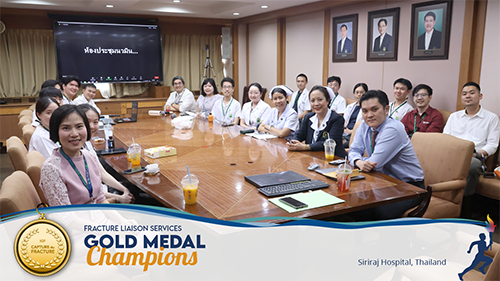
Siriraj Hospital, Bangkok, Thailand
The Siriraj Hospital FLS became a gold-standard FLS in 2017. The FLS sees approximately 300 patients per year, managing all fracture types. They have a strong falls assessment programme where both osteoporosis educators and physical therapists play a role in the intervention.
"A team of specialists in Siriraj Fracture Liaison Service works together to care for patients with fragility fractures and to provide coordinated care for patients with osteoporosis. Our patients receive comprehensive care, including physical therapy and social support."
Nadogaya Hospital FLS, Kashiwa City, Japan
The FLS of Nadogaya Hospital has been listed as a gold-star service by Capture the Fracture® since 2023. The service manages all types of fractures, seeing close to 1000 patients per year.

"We conducted bone density measurements for all patients over 40 years old who were hospitalized with fractures in any part of the body in the orthopedic ward. In addition, we applied an osteoporosis screening sheet for all cases. Through this process, we were able to accurately identify patients who met the criteria for initiating pharmacological treatment according to the guidelines. We then presented the attending physicians with a "Pharmacological Treatment Plan," which detailed the patient's individual fracture risk factors and the recommended drug treatment levels from the guidelines. The attending physician only had to respond to the treatment plan and select the appropriate medication. Thanks to this strategy, known as the "Kashiwa Method," the osteoporosis treatment rate at the time of discharge exceeded 90%. Alongside drug therapy, we also conducted nutritional and exercise therapy, providing multidisciplinary treatment."